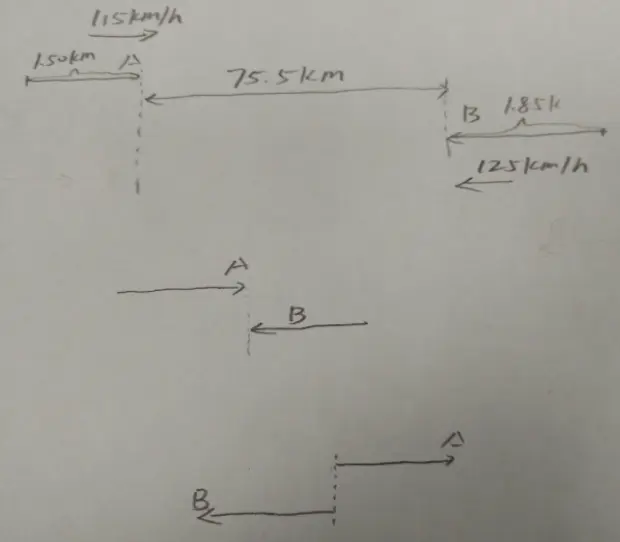Consider two trains A and B. If train A is 1.50 km long and Train B is 1.85 km long. In the beginning, the two trains are 75.5 km apart from each other. Then train A and B start moving toward each other (head to head) on two parallel linear tracks with a speed of 115km/h for train A and 125 km/h for train B.
(1)please figure out how long will it take for the heads of the two trains to meet (Aligned with each other)and the distance traveled by the two trains when the heads meet each other;
(2)please figure out how long will it take for the ends (last car)of the two trains to meet (Aligned with each other)and the distance traveled by the two trains when the ends meet each other.

rames asked 3 years ago
Reading books is a great way to learn. Here are some of the books we recommend.
I've shown two methods for solving this type of questions: graphing and analytical.
Method I: Graphing
(1) Let's study the heads
When two heads meet,lA is the distance travelled by head A and lB is the distance travelled by head B.
Let's supoose that it takes t time for two heads to meet.
So we have,lA=VA×t lA = 115 km/h × t
so,
Also,lB=VB×t lA = 125 km/h × t
so,
Based on the graph,
lA + lB = 75.5
Solving above equations, we get,lA = 36.2 km, lB = 39.3 km
t = 0.314 h,
(2) We study the ends of two trains
Based on the graph,
lA’+lB’ = 1.50 km + 1.85 km + 75.5 km
Solving above equations, we get,lA’ = 37.8, lB’ = 41.1 km
t’ = 0.328 h,
Method II: Analytical
(1) Let's stydy the heads
First we set up a one dimensional coordinate system axis X. Let the origin O coincide with the end of train A and positive direction is to the right.
So at the beginning, the coordinate of head A is +1.50 km and the coordinate of head B is:
1.50 + 75.5 = 77.0 km
Head A coordinate changes with time t according to following equation,
XA = 1.50 km + VA t = 1.50 + 115 × t
Head B coordinate changes with time t according to following equation,
XB = 77.0 km - VB t =77.0 - 125 × t
When they meet,XA = XB
so, 1.50 + 115 × t = 77.0 - 125 × t
so, t = 0.314 h
And,lA = VA×t = 115 × 0.314 = 36.2 km lB = VB×t = 125 × 0.314 = 39.3 km
also,
(2) We study the ends, and we set up the same coordinate system x axis
So at the beginning, the coordinate for end A is 0 and for end B is
1.50 + 75.5 + 1.85 = 78.85 km
And the coordinate of end A changes along with time,
XA’ = 115 km/h × t
The coordinate of end B also changes along with time,
XB’ = 78.85 km - 125 km/h × t
When two end meets, we have,
XA’ = XB’
or, 115 × t = 78.85 - 125 × t
so, t = 0.328 h,lA’ = 37.8 km, XB’ = 41.4 km
Note:lA’ and lA’ can be obtained as we did in method I